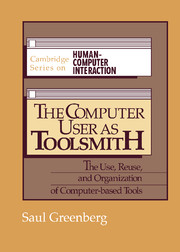
-
Select format
-
- Publisher:
- Cambridge University Press
- Publication date:
- 26 May 2010
- 29 January 1993
- ISBN:
- 9780511629402
- 9780521404303
- Dimensions:
- (253 x 177 mm)
- Weight & Pages:
- 0.67kg, 204 Pages
- Dimensions:
- Weight & Pages:
You may already have access via personal or institutional login- Series:
- Cambridge Series on Human-Computer Interaction (6)
Book description
Computing environments that furnish a large set of tools (such as editors, mail programs and language processors) are difficult to use, primarily because there is no means of organizing the tools so that they are at hand when needed. Because of the dearth of knowledge of how users behave when issuing commands to general purpose computer systems, user support facilities are ad-hoc designs that do not support natural work habits. The Computer User as Toolsmith, first published in 1993, describes several empirical studies from which the author has developed a computer version of a handyman's workbench that would help users with their online activities. For the practitioner and interface designer, the guidelines and principles offered here are directly applicable to the rational design of new systems and the modernization of old ones. For the researcher and graduate student, the book offers a wealth of analysis and interpretation of data, as well as a survey of research techniques.
Reviews
"...thoughtfully and carefully written. It is well referenced, with over 100 citations. The author describes in clear and precise detail how he took his initial premises about tools and their reuse, and developed a research and analysis program to test them." G.R. Mayforth, Computing Reviews
Contents
Metrics
Altmetric attention score
Full text views
Full text views help Loading metrics...
Loading metrics...
* Views captured on Cambridge Core between #date#. This data will be updated every 24 hours.
Usage data cannot currently be displayed.
Accessibility standard: Unknown
Why this information is here
This section outlines the accessibility features of this content - including support for screen readers, full keyboard navigation and high-contrast display options. This may not be relevant for you.
Accessibility Information
Accessibility compliance for the PDF of this book is currently unknown and may be updated in the future.


